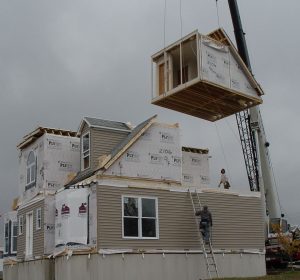Modular Construction: Some Assembly Required


Most parents purchase large toys for their children and dread the phrase: Some Assembly Required. But, when it comes to building your next home, that phrase should be exactly what you want to hear. With modular construction, only some of the work is done onsite. Most of the work is already done off-site. It is more than just a shell. You are getting walls, doors, windows, insulation, drywall, trim, plumbing, electric, kitchens, bathrooms, and flooring up to 75-85% complete off-site. For you, Some Assembly Required means that most of the assembly has taken place in a factory where quality is better controlled and construction takes place indoors. Modular offers the most complete off-site building method for your new home.
Modular – The Most Advanced Off-site Building System
Even today, most homes are built onsite. It’s hard to believe, but home construction hasn’t changed much since 1830. Up until that point, you built a timber frame home (large timbers assembled into a home’s skeleton) or a log cabin. North America has lots of trees so U.S. construction is a wood based construction industry. After 1830, homes started being built the way you see them today, 2’x4′, 2’x6′, or light wood stick frame construction. About 1900 we saw a small improvement when we updated the way we frame houses from balloon framing to platform framing. Other than that, it has remained virtually unchanged in almost two hundred years.
Other methods of construction have been created over the years in the quest to find a better way to build homes. Each of these systems have attempted to do some portion of the construction off-site to either decrease onsite build time, improve quality of construction, and/or reduce costs. Here are several popular off-site building methods in order from least completed to most completed off-site:
Concrete Construction – In its most basic form, a concrete block is used for concrete construction. Blocks are manufactured by the millions and delivered to job sites to be assembled into any number of building types. Other methods include taking concrete that is mixed off-site and delivered to be poured into forms assembled onsite to form some part of the building: walls, floors, ceilings, etc. Once done, all of the utilities, finishes, windows, doors, etc. must be completed onsite.
 Panelized Construction – This method of construction takes a plan and divides it up into panels. There are various methods of panelized construction. In commercial construction, these panels can be made of concrete and delivered to a site for installation. In residential construction, they are typically made of wood. Open wood panels are the entry level of panelized construction. While they frame a home quickly, the rest of the process falls back into the method of typical onsite home construction… building outdoors and subjecting the home being constructed to the elements. In addition, all of the work still requiring all of the same subcontractors is needed. Some forms of panelized construction, such as Structural Insulated Panels (SIPs), offer a more complete panel doing more of the work off-site with final completion still left to be done onsite.
Panelized Construction – This method of construction takes a plan and divides it up into panels. There are various methods of panelized construction. In commercial construction, these panels can be made of concrete and delivered to a site for installation. In residential construction, they are typically made of wood. Open wood panels are the entry level of panelized construction. While they frame a home quickly, the rest of the process falls back into the method of typical onsite home construction… building outdoors and subjecting the home being constructed to the elements. In addition, all of the work still requiring all of the same subcontractors is needed. Some forms of panelized construction, such as Structural Insulated Panels (SIPs), offer a more complete panel doing more of the work off-site with final completion still left to be done onsite.
 Modular Construction – Modular is a type of construction, not a type of home. Modular means a home plan is divided into modules that can built in a factory, shipped to a site, and assembled. This could be as little as one module or more than a dozen depending on the plan. These modules are typically completed within themselves. Drywall, insulation, walls, floors, trim, kitchens, countertops, bathrooms, lighting, plumbing and electrical are almost all done off-site. A typical home built using modular construction is 65-85% complete once it is set on a foundation. This construction takes place in parallel with the site work that is needed when building home. In today’s construction environment, labor is the number one issue facing home builders. The advanced modular building method minimizes onsite construction by maximizing off-site completion of a home’s components in a factory.
Modular Construction – Modular is a type of construction, not a type of home. Modular means a home plan is divided into modules that can built in a factory, shipped to a site, and assembled. This could be as little as one module or more than a dozen depending on the plan. These modules are typically completed within themselves. Drywall, insulation, walls, floors, trim, kitchens, countertops, bathrooms, lighting, plumbing and electrical are almost all done off-site. A typical home built using modular construction is 65-85% complete once it is set on a foundation. This construction takes place in parallel with the site work that is needed when building home. In today’s construction environment, labor is the number one issue facing home builders. The advanced modular building method minimizes onsite construction by maximizing off-site completion of a home’s components in a factory.
Modular is a Process
The modular construction method is a process, a process of dividing a home plan into modules that can be cost effectively built in a factory, delivered to a home site, and then completed quickly. It does this by turning home construction into an efficient manufacturing process versus the current inefficient process of construction in the field. It gains even larger efficiencies because construction is happening at two locations simultaneously. Onsite construction still has to take place. Driveways, utilities, and foundations have to be built… onsite.
Modular moves most of the rest of a home’s construction indoors and constructs it at the exact same time the site work is happening. In traditional construction, these processes have to happen sequentially. You can’t start building a floor if there is no foundation to place it on. Modular minimizes total time to completion by maximizing off-site construction of the home.
Getting the Home You Want
Advancements in modular construction mean that virtually any home plan can be divided into modules, built using indoor off-site construction, and assembled onsite. There are over 20 home plan websites. We have found that about significant percentage of these home plans from leading architects and designers that can be “modularized” and built using this advanced method of construction.
RELATED: CONSTRUCTURING: THE FUTURE OF HOME BUILDING?
Can any custom home plan be modularized? Technically, the answer is yes. There is a way to divide any home plan into modules, build those modules in a factory, and then assemble them onsite. However, the practical answer is that sometimes it just doesn’t make sense. A plan may have to be divided into many modules to be transported to a site or a home plan may have tall ceilings requiring additional modules to stay true to the design. Yes, these homes can still be built using modular construction but the cost to do so outweighs the benefits. In some instances, with slight modification, a plan can be modified to work efficiently with modular construction and at the same time maintain its design integrity.
Bringing Value to Custom Home Building
Modular construction offers the way forward for custom home building. Construction labor in the U.S. is evaporating. The skilled craftsmen from years ago have retired. The process of modular construction instills quality in the home building process that is difficult to duplicate with today’s construction in the field. Homes are the only thing that we use today that aren’t built in a factory.
A modular home factory is efficiency. The onsite building process has perpetuated the inefficiencies of construction for years. Other building systems take a step in the right direction. Modular takes home construction to the next level. Modular means more!
The post Modular Construction: Some Assembly Required appeared first on Impresa Modular.




